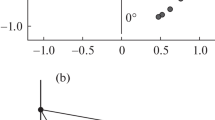Abstract.
We address the issue of what proprioceptive information, regarding movement of the human arm, may be provided to the central nervous system by proprioceptors located within muscles of this limb. To accomplish this we developed a numerical simulation which could provide estimates of the length regimes experienced by a set of model receptors located within some of the principal muscles of the human arm during planar movement of this limb. These receptors were assumed to have characteristics analogous to those associated with a simple model of muscle spindle signalling of movement. To this end each spindle had proprioceptive ‘channels’ associated with it. These corresponded to primary and secondary spindle afferent fibers which could provide independent afferent output regarding the parent muscle the spindle monitored. The angles of the shoulder and elbow joints attained by subjects performing a task requiring movement of the right arm in a horizontal plane to a static visual target were recorded. For this angular data the lengths and rates of change of lengths experienced by muscle fascicles, and hence the model spindles, during movement were calculated by means of the numerical simulation. The discharge rates of the simulated spindles during the movement were calculated to derive a measure of the depth of modulation, induced by the movement, for each spindle. These values were then summed for all spindles to provide a first-order approximation of spindle ensemble coding of the movement. Significant correlations (\(P<\)0.0001, Spearman's rank order) were found between the resulting ensemble encodings and, in order of significance, the angular velocity of the shoulder joint (\(r_{\rm S}=0.945\)), the tangential velocity of the hand (\(r_{\rm S}=0.942\)), and the angular velocity of the elbow joint (\(r_{\rm S}=0.917\)). Correlations between the angular positions of the shoulder (\(r_{\rm S}=-0.623\)) and elbow (\(r_{\rm S}=0.628\)) were lower. These findings indicate that the ensemble profiles of the simulated muscle spindles, encode information regarding kinematic parameters of movements related to both intrinsic and extrinsic coordinate systems. This suggests that motor structures capable of deriving such an ensemble encoding would be in a position to perform the sensory-motor transformations between intrinsic and extrinsic frames of reference necessary for controlling movements planned in extrinsic coordinates.
Similar content being viewed by others
Author information
Authors and Affiliations
Additional information
Received: 12 August 1994 / Accepted in revised form: 17 June 1996
Rights and permissions
About this article
Cite this article
Wallace, K., Kerr, G. A numerical simulation of muscle spindle ensemble encoding during planar movement of the human arm . Biol Cybern 75, 339–350 (1996). https://doi.org/10.1007/s004220050300
Issue Date:
DOI: https://doi.org/10.1007/s004220050300




